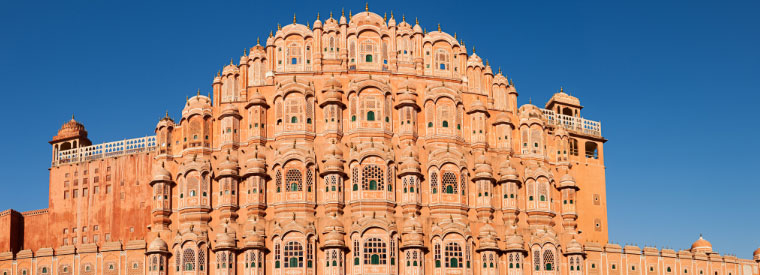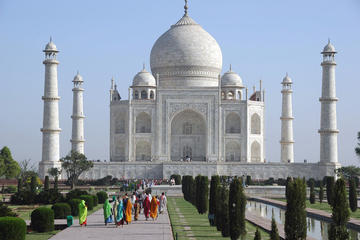« INDIA • Discover India • North India
Discover Magical North India
North India has been the historical center of many empires. It has a diverse culture, and includes the Hindu pilgrimage centers of Char Dham, Haridwar, Mathura, Allahabad and Varanasi, the Buddhist Mahabodhi Temple, the Sikh Golden Temple and the Muslim pilgrimage destination of Ajmer, as well as world heritage sites such as the Valley of flowers, Khajuraho, Bhimbetka Caves, Qutb Minar and the Taj Mahal.

|
Popular Destinations:
Amritsar •
Jaipur •
Jodhpur •
|
• New Delhi

Delhi has been continuously inhabited since the 6th century BC. Through most of its history, Delhi has served as a capital of various kingdoms and empires. It has been captured, sacked and rebuilt several times, particularly during the medieval period, and therefore modern Delhi is a cluster of cities …
• Amritsar

Amritsar is home to the Harmandir Sahib (commonly known as the Golden Temple), the spiritual and cultural center for the Sikh religion. This important Sikh shrine attracts more visitors than the Taj Mahal with more than 100,000 visitors on weekdays alone and is the most popular destination for non-resident Indians …
• Jaipur

The Palace quarter of Jaipur encloses the sprawling Hawa Mahal palace complex, formal gardens, and a small lake. Nahargarh Fort crowns the hill in the northwest corner of the old city. The observatory, Jantar Mantar, is a World Heritage Site. Included on the Golden Triangle tourist circuit, Jaipur is a popular destination …
• Jodhpur

Jodhpur is known as the 'Sun City' for the bright, sunny weather it enjoys all the year round. It is also referred to as the 'Blue City' due to the vivid blue-painted houses around the Mehrangarh Fort. The old city circles the fort and is bounded by a wall with several gates but the city has expanded greatly outside the wall …
• Manali

Manali is named after the lawgiver Manu. The word Manali is regarded as the changed name of 'Manu-Alaya' which literally means 'the abode of Manu'. Legend has it that sage Manu stepped off his ark in Manali to recreate human life after a great flood had deluged the world. Manali is also often referred to as the 'Valley of the Gods' …
• Udaipur

Udaipur is also known for its Rajput-era palaces. The Lake Palace, for instance, covers an entire island in the Pichola Lake. Many of the palaces have been converted into luxury hotels. It is nicknamed the "Lake City". Lake Pichola, Fateh Sagar Lake, Udai Sagar and Swaroop Sagar are considered some of the most beautiful lakes …
• Varanasi

Varanasi grew as an important industrial centre, famous for its muslin and silk fabrics, perfumes, ivory works, and sculpture. Buddha is believed to have founded Buddhism here around 528 BC when he gave his first sermon, 'The Setting in Motion of the Wheel of Dharma', at nearby Sarnath. …
A | B | C | D | E | F | G | H | I | J | K | L | M | N | O | P | Q | R | S | T | U | V | W | X | Y | Z
» Agra

Crowded, congested Agra, a city of some 1.5 million people in Northern India, often lands a spot on any first-time visitor's itinerary for one reason: the magnificent Taj Mahal. While the gorgeous white marble mausoleum and the nearby Agra Fort offer reason enough to visit, few take the time to linger and appreciate the historical significance of a place where one Mughal emperor after another left behind grand architectural wonders as testament to the dynasty's wealth and power …
» Agra Fort

Within a stone's throw of the Taj Mahal, the 16th-century Agra Fort serves as another testament to the immense wealth and power of the Mughal Empire. Recognized as a UNESCO World Heritage site in 1983, the Agra Fort was initially built by Akbar in 1565 on the same site as a previous fort on the banks of the Yamuna River. A succession of a half-dozen other emperors, including Humayun and Shah Jahan, has lived within the red sandstone walls. While called a fort, the structures are more akin to a complex of exquisite palaces …
» Ajmer

The city of Ajmer is a whirlwind of activity and excitement tucked between the quiet Ana Sagar Lake and the picturesque Aravalli Hills. The fifth largest city in Rajasthan, Ajmer is known as an important hub for Islamic history, culture and early Muslim architecture, as well as a destination for followers of the Jain religion. For this reason, travelers will find a number of noteworthy religious structures, like the Dargah Sharif of Khwaja Moinuddin Chishti, which is visited by some 125,000 people each year …
» Bharatpur

A fortress city in Rajasthan, Bharatpur was founded in the 18th century when it was ruled by the Jat people. According to legend, the city's name derives from Bharat, the brother of Lord Rama, who was one of the incarnations of Vishnu. Today it is most famous for its proximity to the Keoladeo National Park (Bharatpur Bird Sanctuary,), an important stop on many migratory bird paths across Asia. Visiting the city is a way to access the city's history and cultural heritage. It was founded by Maharaja Suraj Mal in 1733 …
» Chand Baori

Chand Baori, one of the deepest and largest step wells in the world, is also one of India's most overlooked and incredible sights. An Escher-like maze of 3,500 symmetrical stone steps descent 100 feet (30 meters) into the ground, culminating in a well where locals once came to draw water. The well is so deep, the temperature at the bottom is often several degrees cooler than on the surface. The well, along with nearby Harshat Mata Temple, were built between 800 and 900 AD by King Chand Raja …
» Deeg Palace

The Deeg Palace was built as a summer home for the Jat kings of nearby Bharatpur in the 16th century and was used as a luxurious holiday home for Maharajas until the 1970s. Deeg was also the site of a large battle between the Mughals and the Jats. After Prince Suraj Mal's victory, he eventually captured and plundered the Red Fort in Delhi and carried away valuables from the building to construct the Deeg Palace. The granite, marble and stone materials now make up the arches, halls and pillars of the palace …
» Fatehpur Sikri

Set 25 miles (40 km) west of Agra lies the deserted city of Fatehpur Sikri (City of Victory), built by Akbar in the late 16th century to serve as the new capital of the Mughal Empire. For 14 years from 1571 to 1585, the red sandstone-fortified city served as the dynasty's seat of power, and at its peak, Englishman Ralph Fitch found it to be considerably larger and grander than even London. This grandeur was short-lived, however, as in 1585, Akbar moved the capital to Lahore in his campaign against Afghan tribes …
» Keoladeo National Park (Bharatpur Bird Sanctuary)

Keoladeo National Park is a famous bird sanctuary in Bharatpur that is home to over 350 different species of birds. Formerly a duck-hunting site of the Maharajas, it was declared a protected sanctuary in India in 1982 and is now also a UNESCO World Heritage site. Many of the birds migrate from all over Asia in the winter months, from areas such as China, Afghanistan and Turkmenistan. Ducks, coots, geese and pelican sightings are common all over the park's waters, while eagles, warblers, osprey, partridges …
» Kumbhalgarh Fort

Nicknamed the Great Wall of India, the walls of Kumbhalgarh Fort in Rajasthan are the second-longest in the world after the Great Wall of China. This massive citadel was constructed during the fifteenth century under the direction of Rana Kumbha, the then ruler of the kingdom of Mewar. While it took well over a decade to complete, the fort served as an important refuge for Mewali rulers during times of war, most notably Prince Udai who was smuggled into the fort as an infant in 1535 …
» Mandawa

Mandawa is a town the Jhunjhunu district of Mumbai known for its vast and artfully detailed havelis, which are the former private mansions of 18th-century merchants. Havelis are known for their beautifully painted walls, opulent architecture and expansive inner courtyards. The haveli paintings depict life and religious scenes in great detail, often telling the history of the area from centuries ago. Images range from the gold leaf painted room of the Jhunjhunwlala Haveli to portraits of Maharajas …
» Mansa Devi Temple

Mansa Devi Temple is a Hindu temple dedicated to the wish-granting goddess Mansa Devi. It's located on the top of a hill in Haridwar, which is one of seven holy pilgrimage centers in India known as Sapta Puri. Mansa Devi Temple is a hugely popular site, with hundreds of pilgrims flocking to it daily with their prasad (food offerings) for the goddess in the hopes of getting their wishes granted. Visitors can either walk the one and a half kilometers up the hill to the temple, or take a cable car ride up instead …
» National Chambal Sanctuary

Straddling three states, Rajasthan, Madhya Pradesh and Uttar Pradesh, the National Chambal Sanctuary protects 245 square miles (635 square kilometers) of natural habitat where the Chambal and Yamuna Rivers meet. Established in 1979 to protect the endangered Gharial crocodiles, the park is now home to number of rare and endangered species, including the Ganges River dolphin, marsh crocodile, smooth-coated otter, Indian wold, Indian striped hyena and eight species of turtles …
» Pushkar

Located 179 miles (288 kilometer) west of Jaipur along the edge of the Thar Desert sits the town of Pushkar, one of India's most sacred pilgrimage sites. According to legend, the god Brahma dropped a lotus flower to earth, and the petals landed in three places. One of those places was Pushkar, where a holy lake was formed. Even though Brahma is the creator in Hinduism, Pushkar houses one of the only temples to him in the world -- one of some 500 in the city. Today, visitors come to Pushkar to visit the Brahma Temple …
» Taj Mahal

Considered one of the world's most iconic landmarks, and elected as one of the New Seven Wonders of the World, the Taj Mahal is a living testament to grandeur, romance, and historical significance. As India's most recognizable structure, the Taj Mahal was built by Mughal Emperor Shah Jahan in memory to his favorite wife. Its interior is complete with blossoming and vibrant exotic gardens, reflecting pools, and an impressive mosque. Photography does no justice to the majesty of this awe-inspiring tomb …
« INDIA • Discover India • North India






